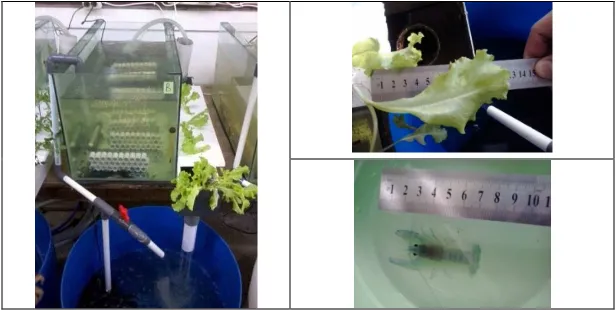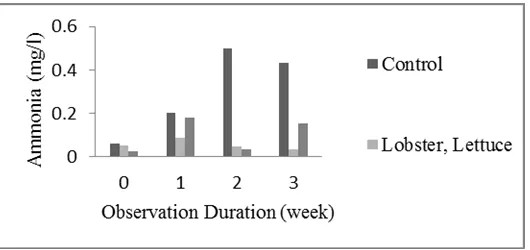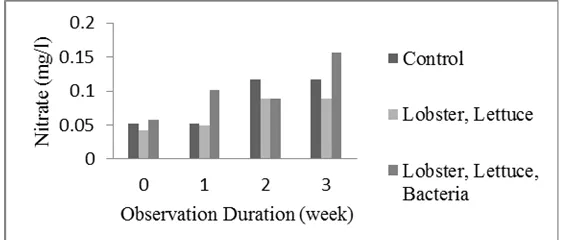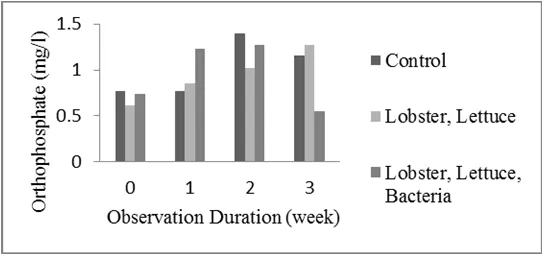ISSN 0973-6077 Volume 10, Number 1 (2015), pp. 409-420 © Research India Publications
http://www.ripublication.com
Wastewater Treatment Of Freshwater Crayfish
(
Cherax quadricarinatus
) Culture With Lettuce
(
Lactuca sativa
)
Hefni Effendi1)*, Bagus AmalrullahUtomo1), Giri Maruto Darmawangsa2), Dwi Aprianti Hanafiah3)
1)Environmental Research Center, Bogor Agricultural University (IPB)
2)Aquaculture Diploma Program, Bogor Agricultural University (IPB)
3)
Department of Aquatic Resources Management, Bogor Agricultural University (IPB)
*
Corresponding Author Environmental Research Center Gedung PPLH, Kampus IPB Dramaga, Bogor, Indonesia Tel. 62-251-8621262, Fax. 62-251-8622134 Email:
hefni_effendi@yahoo.com
ABSTRACT
The objective of this study was to treat freshwater crayfish Red Claw (Cherax quadricarinatus) culture wastewater containing organic material of residual feed and feces by bioremediation using aquaponic recirculating system with lettuce (Lactuca sativa). Aquaponic bioremediation of crayfish culture wastewater with lettuce attained ammonia and nitrate reduction up to 90.1% and 23.3%, respectively, during three weeks observation. At the end of experiment, the average length of crayfish was 6.27cm (control) and 7.12cm (treatment). Crayfish weight of control was 6.12g, and crayfish weight of treatment was 8.12g. Crayfish growth rate ranged 0.95-1.01 g/day. The length of lettuce during observation ranged 8.9 - 12.0 cm. Lettuce RGR was 0.04 cm/day.
Keywords: Aquaponic, Ammonia, Bioremediation, Freshwater crayfish, Lettuce
INTRODUCTION
Furthermore, it can inhibit the growth of cultured aquatic biota (Anonymous 2007, Ling and Weimin 2010, Yeo et al. 2004).
Bioremediation is a process of biodegradation to remove or detoxify pollutants entering the environment as contaminants in soil, water, and sediment (Hazra et al. 2011, Hinchman et al. 1996, Thapa et al. 2012). Bioremediation is closely related to the biological activity of microorganisms and plants. The principle of bioremediation by aquatic plants is the process of filtering and absorption by the roots and stems of aquatic plants, as well as the process of exchange and absorption of dissolved ions used for plant growth (Anonymous 2007, Turcios and Papenbrock 2014, Yusuf 2008).
Red Claw is native to the waters of the river in the northeast of Australia and Papua New Guinea. Crayfish is endemic to the tropics of northeastern Australia. Freshwater crayfish is easily cultivated, not susceptible to disease, eating plants and animals (omnivores), fast-growing, and high fecundity (Anonymous 2011, FAO 2011, Sukmajaya dan Suharjo 2003).
Fertilizers and feeds are applied to ponds to promote shrimp and fish production, and no more than 25% to 30% of the nitrogen and phosphorus applied to ponds in fertilizers and feeds is recovered in fish or shrimp at harvest (Boyd and Tucker 1998). Ponds often have higher concentrations of nutrients, plankton, suspended solids, and oxygen demand than the water bodies into which they discharge (Schwartz and Boyd 1994b). Thus, pond effluents are potential sources of pollution in receiving waters (Boyd 2003).
Aquaponic system is a combination of aquaculture and hydroponics cultivation. In this system, fish and plants grow in one integrated system and creating a symbiotic (Allsopp et al. 2009). This technology is an applied technology saving land and water in aquaculture, so it can serve as a fishery model in tight areas or shortage of land as urban or residential complex (Diver 2006, Kumar and Sierp 2003). Aquaponic system uses recirculation concept with an aqueous medium for the production of plants without soil. Recirculation system is designed to increase the number of fish or shrimp produced in the relatively small volume of water, organic waste products are absorbed by plants (Allsopp et al. 2009, Diver 2006, Qin et al. 2005, Wik et al. 2008). Aim of experiment was to treat freshwater crayfish (Cherax quadricarinatus) culture wastewater with lettuce (Lactuca sativa) in recirculating system of aquaponic.
MATERIALS AND METHODS
Experimental Design
Several treatments consisted of (1) Crayfish without lettuce, (2) Crayfish and lettuce, (3) Crayfish, lettuce, and bacteria. Experiment was performed at recirculating aquaculture systems, consisting of aquarium (80 x 40 x 40 cm3), ditch, container, and submersible pump.
avoid lettuce leaf submerged under water. Commercial Bacteria combination of Microplus (Aerobacter sp, Nitrobacter sp, Nitrosomonas sp, Lactobacillus sp, Saccharomyces sp) was inoculated to the system.
Water from crayfish aquarium containing organic substances (residual feed and feces) was flowed into a ditch planted with lettuce. Water was further flowed into a container which was previously inoculated with bacterial mixture (0.5 l). Then water was pumped back into crayfish aquarium (Figure 1), without water replacement.
Water quality parameters analyzed included temperature, pH, Dissolved Oxygen, Ammonia, Nitrate, Orthophosphate, dan Total Sulfide (APHA 2008). Bacterial abundance (Cfu/ml) was determined. Lettuce length measurement was performed at leaf. Crayfish length was measured from rostrum until tail end (Figure 1).
Figure 1. Recirculating aquarium system, lettuce leaf and crayfish length measurement.
Survival Rate
SR = x 100% Where
SR : Survival rate
No : Number of crayfish at the beginning of experiment Nt : Number of crayfish at the end of experiment
Growth Rate
Where
: Growth rate (%)
Wt : Weight of crayfish at the end of experiment (g)
W0 : Weight of crayfish at the beginning of experiment (g)
Relative Growth Rate
Where
RGR : Relative growth rate
Xt : Lettuce length at the end of experiment Xo : Lettuce length at the beginning of experiment
∆t : Experimental duration
Water Quality Reduction
% Reduction = [(a-b)/a] x 100% Where
a: Control concentration of water quality parameter at time t b: Treatment concentration of water quality parameter at time t
RESULT AND DISCUSSION
Temperature and pH
Temperature influences growth of biota and chemical reaction at aquatic ecosystem (Tchobanoglous et al. 2004). Observed temperature ranged 27-29 0C. Freshwater crayfish culture grows optimum at temperature of 24-29 0C (Budiardi et al. 2008).
Lowest control aquarium pH was 6.46. Range of pH suitable for growth of aquatic biota and plant was 6.8-8.5 (Gjesteland 2013, Pescod 1973), 6-9 (Boyd 2003). Range of pH supporting crayfish media growth ranges 7-8 (Lukito and Prayugo 2007). pH <5 does not accommodate crayfish life, meanwhile pH >9 decreases crayfish feeding appetite (Budiardi et al. 2008).
Dissolved Oxygen(DO)
Dissolved oxygen are required by all living things for respiration, metabolism, and exchange of substances, which then produce energy for growth and reproduction, and also needed to oxidize organic materials and inorganic in aerobic process (Boyd 1990). Dissolved oxygen in water comes from the photosynthesis of phytoplankton and aquatic plants as well as diffusion of air (Eaton et al. 2005).
Dissolved oxygen levels were never <5 mg/l during the observation, which denoted that the dissolved oxygen levels are in good condition. Dissolved oxygen for supporting the growth of freshwater crayfish is >5 mg/l (Lukito and Prayugo 2007, Boyd 2003). Range of temperature, pH and dissolved oxygen in the experiment was conducive to the growth of crayfish. Temperature range of 25-29oC facilitates the pH and oxygen levels in the water occurring in favorable conditions.
Ammonia
Ammonia in waters derived from the breakdown of organic nitrogen and inorganic nitrogen contained in the water originating from the decomposition of organic matter by microbes and fungi. Ammonia is the major toxic nitrogenous metabolic product excreted from fish in dissolved form (Yeo et al. 2004).
Figure 2. Ammonia concentration of control and treatment aquarium.
Ammonia concentration of both treatments (0.0249-0.1830 mg/l) was lower compared with that of control aquarium (0.0626-0.4996 mg /l) (Figure 2). Since there was no lettuce and bacteria combination at control aquarium that can help the process of nitrification. Decrease in the concentration of ammonia can occur because of ammonia conversion into nitrite and nitrate through the nitrification process. The concentration of ammonia in water for cultivation is 0.2-3 mg/l (Boyd 1990). Percentage reduction of ammonia concentration reached 91.5% for the treatment aquarium. This is consistent with the statement of Ika and Rifa'i (2012), the concentration of ammonia in the pond will be filtered out to 80% by the plant. The root zones are superb micro-sites for bacterial communities. These bacteria carry out nitrification and thus make N available for absorption (Baruah et al. 2006).
Depending on the pH and temperature of the water, a certain percentage of the total ammonia will be in the ionized non toxic form (NH4+) and some will be in the
highly toxic unionized form (NH3), the higher the pH or water temperature, the greater
the percentage of ammonia remaining unionized (Yeo et al. 2004).
more toxic form attributable to the fact that it is uncharged and lipid soluble and consequently traverses biological membranes more readily than the charged and hydrated NH4+ ions (Crab et al. 2007, Körner et al. 2001). When NH4+ and nitrate
(NO3+) are present simultaneously, plant removes NH4+ faster than NO3+. NH4+ is the
preferred form for plant growth because the incorporation of NO3+ requires additional
metabolic energy and enzymatic activity (Baruah et al. 2006).
Nitrate
Nitrate is a compound that is formed from the oxidation of nitrite (NO2) to
nitrate (NO3) by the Nitrobacter bacteria. Goldman and Horne (1983) stated that nitrite
in the water will be converted into nitrate form under sufficient oxygen concentration, and nitrate in the water is more stable than nitrite.
Figure 3. Nitrate concentration of control and treatment aquarium.
The concentration of nitrate in the control aquarium tended higher than that in treatment aquarium (Figure 3). This is because of the usage of most nitrate by lettuce as nutrient for plant growth. Nitrate levels safe for aquaculture range of 0-3 mg/l (Bansal et al. 2007).
Percentage change of nitrate concentration is lower than the percentage change of ammonia concentration (Table 1). Largest percentage change of 91.5% ammonia occurred at observation 3 and 23.3% nitrate at the observation 2 and 3 for treatment with crayfish and lettuce. Meanwhile, for treatment with crayfish, lettuce, and bacteria combination, nitrate concentration increased. This might relate with the existence of inoculated bacterial combination to system undergoing much intensive organic matter degradation. Ammonia concentration of treatment with crayfish, lettuce and bacteria combination was also slightly higher.
Table 1. Percentage of ammonia and nitrate reduction.
Observation
Reduction Percentage (%)
Plants can lower 98% and 94% of the total nitrogen and inorganic nitrogen respectively. In addition, the plant is able to decrease 97% total phosphorus and 97% dissolved phosphorus (Brown et al. 1999). Treatment of water spinach (Ipomoea aquatic) for 120 days can reduce 30.6% total nitrogen and 18.2% total phosphorus (Li and Li 2009). Treatment with aquatic plants can reduce NH4-N (55.9-76.0%), NO2-N
(49.6-90.6%), NO3-N (34.5-54.4%), and PO4-P (64.5-76.8%) (Snow and Ghaly 2008),
decrease of NO3-N (82.9 - 98.1%), NO2-N (95.9 - 99.5%), and phosphate (54.5 -
93.6%) (Ghaly et al. 2005). Anonymous (2007) found that reduction of total phosphate was also lower than that of ammonia reduction of aquaculture wastewater treated with plant. The macrophyte cultivating area and open area formed a purification system. Their purification mechanisms are described as follows (Baruah et al. 2006), (1) Nitrogen removal process via nitrification (aerobic condition) converting NH4+→ NO2
→ NO3, denitrification (anaerobic condition) converting NO3 → NO2 →NO → N2O
→N2, and(2) Phosphorus removal process.
Orthophosphate
Orthophosphate is utilized by bacteria, phytoplankton, and aquatic plants. Phosphorus absorption by aquatic plants is slower than absorption by phytoplankton, but aquatic plants can absorb and store phosphorus in greater numbers (Boyd 1990).
Figure 4. Orthophosphate concentration of control and treatment aquarium. Orthophosphate levels in both treatments (0.5512-1.2691 mg/l) tended to be lower than controls (0.771-1.4019 mg/l) (Figure 4). This is due to the orthophosphate used by lettuce for growth. According to Boyd (1990), plants can absorb and store phosphorus in greater numbers. Safe orthophosphate concentration in the water is from 0.01 to 3 mg/l (Bansal 2007), <0.5 mg/l total phosphorous (Boyd 2003).
Studies in India showed that about one million litres per day of domestic sewage could be treated over an area of one hectare by using water hyacinth which reduces the BOD and COD by 89 and 71% along with removal of 89 % nitrogen and 50 % of phosphorus (Kumar and Sierp, 2003).
fish produced. The calculated average discharge was 8.2 kg phosphorus and 64.7 kg nitrogen per tonne of fish produced (Alanara et al. 2006 in Anonymous 2007). Hence, phosphorus and nitrogen are a prominent aquatic waste problem in aquaculture need to be removed.
Total Sulfide
Sulfide derived from the decomposition of organic compounds, can also be of industrial waste, but mainly from the reduction of sulfate compounds (Sugiarti et al. 2011). Total sulfide concentration in both treatments and control was 0.0019 mg/l. H2S concentration was positively correlated with total sulfide concentration meaning
that the total sulfide concentration increase will be followed by the increase in the concentration of H2S. Levels of total sulfide (H2S, HS-, and S2-) <0.002 mg/l is
considered not harmful to aquatic organisms survival (Effendi 2003, Sugiarti et al. 2011). The concentration of contaminants should not be in excess to ensure that they do not affect the growth rate of the plant species as excess may cause toxicity (Hazra et al. 2011).
Survival Rate
Survival rate (SR) is a measure denoting how many lobsters survive for observations in percent. SR in treatment aquarium (96.6%) was higher than that of control aquarium (76.6%). Crayfish deaths may be related to higher ammonia levels in control, and is also caused by cannibalism. This is consistent with the statement Budiardi et al. (2008), that the death occurred during the cultivation, one of them caused by cannibalism. An attempt to use extreme culture media of geothermal-heated water for farming of freshwater prawns (Macrobrachium rosenbergii) has been demonstrated to be feasible in a non-tropical climate (Johnson 1978). Hence prawn is quite tolerant.
Length, Weight, and Growth Rate of Crayfish
The average length of crayfish on the observations was 6.27cm (control) and 7.12cm (treatment). Freshwater crayfish grows and develops optimally in a good environment and adequate nutrition. Budiardi et al. (2008) suggested that intensive cultivation can be successful if four factors are controlled namely water temperature, feed, dissolved oxygen, and waste metabolites.
Lettuce Length
The length of lettuce during observation ranged 8.9 - 12.0 cm. RGR was 0.04 cm/day. This indicates that the lettuce grows in crayfish cultivation medium. Lettuce is a vegetable that should be free of water stress condition, because it is very sensitive to drought due to the shallow root system (Tsabedze dan Wahome 2010). Water stress is one factor that limits plant growth (Kizil et al. 2012).
The presence of organic matter also affects the growth of lettuce. Nutrient needs were fulfilled from decomposition of organic matter contained in the water used for crayfish cultivation. Nutrients resulting from decomposition of organic matter will be used by autotrophs organisms, such as aquatic plants and phytoplankton (Tchobanoglous et al. 2004). Phytoremediation takes advantage of the unique and selective uptake capabilities of plant root systems, together with the translocation, bioaccumulation, and contaminant storage/degradation abilities of the entire plant body (Hinchman et al. 1996).
Bacterial Abundance
Total number of bacteria increased at the observation 2 from 5.1 millions CFU/ml to 32 millions CFU/ml and decreased at observation 3 to be 12 millions CFU/ml. The increase of total bacteria number at observations 1 and 2 showed that the bacteria are in the log phase of growth (rapid growth). This is due to the presence of organic matter content in the crayfish cultivation medium used by bacteria to make new cells and multiplication. Bacteria in the water can grow optimally at pH 6.5-8.5 (Badjoeri and Widiyanto 2008, Tchobanoglous et al. 2004). The biological community acts upon the dissolved wastes and helps to stabilize and recycle waste (Yeo et al. 2004)
In aquaponic recirculation system, the process of decomposition of organic matter took place in aerobic conditions, since the oxygen content is always >5 mg/l. If the availability of oxygen in the water is not sufficient, then there is the anaerobic decomposition, producing toxic gases (H2S, NH3, and CH4) that are harmful to aquatic
biota. The higher the organic matter, the more oxygen required by the bacteria.
CONCLUSION
ACKNOWLEDGEMENT
Thanks are due to Directorate General of Higher Education of Indonesia for providing the research grant.
REFERENCES
1. Anonymous, 2007, Manual on effluent treatment in aquaculture: Science and Practice, European Union, 163 p.
2. Anonymous, 2011, Identifying Freshwater Crayfish, Fisheries Fact Sheet, Department of Fisheries. Government of Western Australia, 4 p.
3. Allsopp, M., Page, R., Johnston, P., and Santillo, D., 2009, State of the world’s oceans. Springer Science, London.
4. [APHA] American Public Health Association. 2008. Standard Method for The Examination of Water and Wastewater, Water Pollution Control Federation. Baltimore, Maryland (US), 1202p.
5. Badjoeri, M., and Widianto, T., 2008, Utilization of nitrifying bacteria for bioremediation and its effect on the concentration of ammonia and nitrite at shrimp farms, Jurnal Oseanologi dan Limnologi di Indonesia, 34(2), 243-259 (In Indonesian).
6. Bansal, A.K., Mitra, A., Arora, R.P., Gupta, T., and Singhvi, B.S.M., 2007, Biological treatment of domestic wastewater for aquaculture, Journal of Agricultural and Biological Science, 2(1), 6-12.
7. Baruah, K., Norouzitallab, P., and Sorgeloos, P., 2006, Seaweeds: an ideal component for wastewater treatment for use in aquaculture, Aquaculture Europe, 3,1-4.
8. Boyd, C.E., 1990, Water quality management in pond fish culture. International center for aquaculture agricultural experiment station, Auburn University, Alabama.
9. Boyd, C.E., 2003, Guidelines for aquaculture effluent management at the farm-level, Aquaculture, 226,101– 112.
10.Boyd, C.E., and Tucker, C.S., 1998, Pond Aquaculture Water Quality Management, Kluwer Academic Publishers, Boston, MA, 700 pp.
11.Brown, J.J., Glenn, E.P., Fitzsimmons, K.M., and Smith, S.E., 1999, Halophytes for the treatment of saline aquaculture effluent, Aquaculture, 175,255-268.
12.Budiardi, T., Irawan, D.Y., Wahjuningrum, D., 2008, Growth and survival of lobsters Cherax quadricarinatus reared in recirculation systems with different densities, Jurnal Akuakultur Indonesia, 7(2), 109-114 (In Indonesian).
13.Crab, R., Avnimelech, Y., Defoirdt, T., Bossier, P., and Verstraete, W., 2007, Nitrogen removal techniques in aquaculture for a sustainable production. Aquaculture 270:1–14.
15.Effendi, H., 2003, Water quality for living aquatic resources management. Kanisius Press, Yogyakarta (In Indonesian).
16.[FAO] Food and Agricultural Organization, 2011, Cultured aquatic species information programme, Cherax quadricarinatus. Cultured aquatic species information programme, FAO Fisheries and Aquaculture Department. Rome. 17.Ghaly, A.E., Kamal, M., and Mahmoud, N.S., 2005, Phytoremediation of
aquaculture wastewater for water recycling and production of fish feed, Environment International, 31,1–13.
18.Gjesteland, I., 2013, Study of water quality of resirculated water in aquaponic system [tesis], Norwegian Univ. Bergen.
19.Hazra, M., Avishek, K., and Pathak, G., 2011, Developing an artificial wetland system for wastewater treatment: a designing perspective, International Journal of Environmental Protection, 1(1), 8-18.
20.Hinchman, R.R., Negri, M.C., and Gatliff, E.G., 1996, Phytoremediation: using green plants to clean up contaminated soil, groundwater, and wastewater, Argonne National Laboratory, Applied Natural Sciences, Inc., 10 p.
21.Huisman, E.A., 1987, The Principles of Fish Culture Production, Department of Aquaculture, Wageningen University, Netherland.
22.Johnson, W.C., 1978. Culture of freshwater prawns (Macrobrachium rosenbergii) using geothermal waste water, Geo-Heat Center. Klamath Falls, OR 97601, USA. 23.Kizil, U., Genc, L., Inalpulat, M., Sapolyo, D., and Mirik, M., 2012, Lettuce
(Lactuca sativa L.) yield prediction under water stress using artificial network (ANN) model and vegetation indices, Journal of Agriculture, 99(4), 409-418. 24.Körner, S., Das, S.K., Veenstra, S., and Vermaat, J.E., 2001, The effect of pH
variation at the ammonium/ammonia equilibrium in wastewater and its toxicity to Lemna gibba, Aquatic Botany , 71,71–78.
25.Kordi, M.G.H.K., and Tancung, A.B., 2007, Water quality management in aquaculture, Rineka Cipta Press, Jakarta (In Indonesian).
26.Kumar, M.S., and Sierp, M., 2003. Integrated wastewater treatment and aquaculture production, A report for the Rural Industries Research and Development Corporation, RIRDC Publication No 03/026, 69 p.
27.Li, W., and Li, Z., 2009, In situ nutrient removal from aquaculture wastewater by aquatic vegetable Ipomoea aquatica on floating beds, Water Science & Technology, 59(10),1937–1943.
28.Ling, C., and Weimin, W., 2010, Wastewater management in freshwater pond aquaculture in China, Sustainability in Food and Water: An Asian Perspective, Alliance for Global Sustainability Bookseries 18.
29.Lukito, A., and Prayugo, S., 2007, Complete guide of freshwater lobster, Penebar Swadaya Press, Jakarta (In Indonesian).
30.Mitchell, D.S., 1974, The development of excessive populations of aquatic plants, Aquatic vegetation and its use and control, UNESCO, Paris.
31.Pescod, M.B., 1973, Investigation of rational effluent stream standards for tropical countries, AIT, Bangkok.
technology: a pilot study on Coconut Island, Hawaii, Aquacultural Engineering, 32(3–4), 365–378.
33.Rouse, D.B., and Kahn, B.M., 1998, Production of Australian red claw Cherax quadricarinatus in polyculture with nile tilapia Oreochromis niloticus, Journal of The World Aquaculture Society, 29(3): 340-344.
34.Snow, A.M., and Ghaly, A.E., 2008, A comparative study of the purification of aquaculture wastewater using water hyacinth, water lettuce and parrot’s feather, American Journal of Applied Sciences, 5(4),440-453.
35.Soffer, H., and Burger, D.W., 1988, Effects of dissolved oxygen concentrations in aero-hydroponics on the formation and growth of adventitious roots, Journals of The American Society for Horticultural Science, 113(2), 218-221.
36.Sukmajaya, Y., and Suharjo, 2003, Freshwater Lobster, a prospect fisheries commodity, Agromedia Pustaka, Jakarta (In Indonesian).
37.Schwartz, M.F., Boyd, C.E., 1994. Effluent quality during harvest of channel catfish from watershed ponds, Progressive Fish-Culturist, 56,25–32.
38.Tchobanoglous, G., Burton, F.L., and Stensel, H.D., 2004, Wastewater engineering: treatment and reuse, Fourth Edition, Metcalf and Eddy, New York. 39.Thapa, B., Kumar, K.C.A., and Ghimire, A., 2012, A review on bioremediation of
petroleum hydrocarbon contaminants in soil, Kathmandu University Journal of Science, Enginering and Technology , 8(1), 164-170.
40.Turcios, A.E., and Papenbrock, J., 2014, Sustainable treatment of aquaculture effluents—what can we learn from the past for the future ? Sustainability, 6,836-856.
41.Tsabedze, M.W., and Wahome, P.K., 2010, Influence of different irigation regimes on production of lettuce (Lactuca sativa L.), American-Eurasian Journal Agriculture and Environment Science, 8(3), 233-238.
42.Webster, C.D., Thompson, K.R., Muzinic, L.A., Yancey, D.H., Dasgupta, S., Xiong, Y.L., Rouse, D.B., and Manomaitis, L., 2004, A preliminary assessment of growth, survival, yield, and economic return of Australian red claw crayfish, Cherax quadricarinatus, stocked at three densities in earthen ponds in a cool, temperate climate, Journal of Applied Aquaculture, 15(3/4), 37-50.
43.Yeo, S.E., Binkowski, F.P., and Morris, J.E. 2004, Aquaculture effluents and waste by product. Sea Grant University of Wisconsin, USA, 61 p.
44.Yoshida, S., Ktano, M., and Eguchi, H., 1997, Growth of lettuce plants (Lactuca sativa L.) under control of dissolved O2 concentratiom in hydroponics, Journal of
Biotronics, 26, 39-45.
45.Yusuf, G., 2008, Bioremediation of domestic waste with aquatic plant simulation. Jurnal Bumi Lestari, 8(2),136-144 (In Indonesian).



